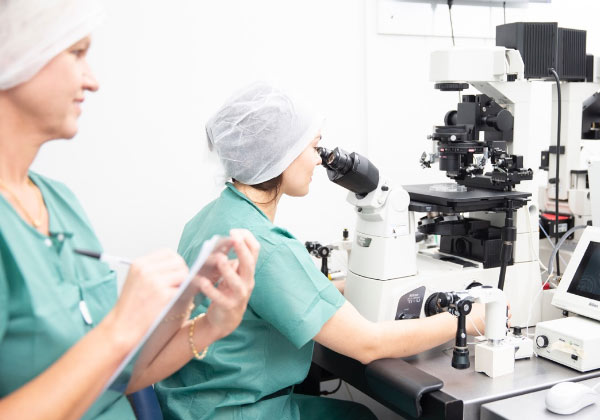代孕胚胎移植手术的过程详解

代孕 是一种帮助无法自行怀孕的人成为父母的方式。在这个过程中,最重要的一步是 胚胎移植手术。本文将使用简单的语言和清晰的列表来解释这一过程,并结合研究和专家的数据,确保内容易于理解。
1. 胚胎移植前的准备
第一步:激素治疗
在胚胎移植之前,代孕母亲需要接受一系列的医学准备,其中最重要的一步是服用 激素药物。这些药物的主要作用是调节代孕母亲的体内激素水平,帮助子宫内膜变得厚实且适合胚胎着床。医生通常会开具 雌激素 和 黄体酮 两种关键药物,前者帮助子宫内膜增厚,后者则维持子宫环境的稳定性,确保胚胎能够顺利附着和发育。
- 血液测试 和 超声波检查 是激素治疗的重要组成部分。医生会通过这些检查定期监测代孕母亲的激素水平和子宫状况,以确保她的身体已经为胚胎移植做好了准备。例如,医生可能会要求代孕母亲在月经周期的第二天或第三天进行检查,以便评估子宫内膜的状态和卵巢功能。
- 子宫内膜厚度 是胚胎成功着床的关键因素之一。研究表明,理想的子宫内膜厚度通常为 8-12毫米,如果厚度不足,可能会影响胚胎的附着能力。因此,医生会根据检查结果调整激素药物的剂量,以达到最佳效果。
第二步:选择最佳胚胎
胚胎的选择过程至关重要,因为它直接影响胚胎移植的成功率。以下是胚胎选择的主要步骤:
- 胚胎培养:在实验室中,卵子和精子结合形成受精卵后,胚胎会在特定的环境中培养几天,直到达到 囊胚阶段(通常是第5-6天)。囊胚阶段的胚胎被认为具有更高的着床潜力,因为它们已经经历了初步的自然筛选过程。
- 基因检测:为了进一步提高成功率,医生可能会建议进行 植入前遗传学检测 (PGT)。这种检测可以筛查出染色体异常的胚胎,从而选择健康的胚胎进行移植。研究表明,经过基因检测的胚胎移植成功率可高达 75-80%,显著高于未检测的胚胎。

第三步:心理准备
代孕不仅涉及身体上的调整,还需要心理上的支持。代孕母亲在整个过程中可能会经历情绪波动,尤其是在等待妊娠测试结果期间。这些情绪波动可能源于对结果的不确定性和对自身角色的认知压力。
为了帮助代孕母亲更好地应对这些挑战,建议她加入 支持小组 或咨询专业心理医生。支持小组可以为代孕母亲提供情感支持和经验分享,而心理咨询则可以帮助她缓解焦虑、建立积极的心态。此外,准父母也可以通过与代孕母亲保持良好的沟通,帮助她感受到更多的支持和理解。
通过以上三方面的充分准备,代孕母亲的身体和心理状态将更加适合胚胎移植,从而为成功妊娠奠定坚实的基础。
2. 胚胎移植手术
手术的具体步骤
胚胎移植手术是一个快速且无痛的过程,通常不需要麻醉,整个过程大约只需 10-15分钟 。以下是具体步骤:
- 准备工作:代孕母亲需要平躺在病床上,医生会使用 经阴道超声波 来定位子宫的最佳位置。这一步非常重要,因为它确保胚胎被放置在子宫内膜最适合着床的区域。此外,医生可能会要求代孕母亲提前憋尿,以帮助超声波更清晰地显示子宫的位置。
- 胚胎移植导管:医生将筛选出的优质胚胎装载到一根细小的 胚胎移植导管 中,然后通过宫颈口将胚胎精准地放入子宫腔中。这一过程通常在超声引导下完成,确保胚胎被放置在最佳位置。
- 术后观察:手术完成后,代孕母亲会被要求在医院休息一段时间,随后可以回家。虽然手术本身无需住院,但术后护理对成功率至关重要。
术后注意事项
为了提高胚胎着床的成功率,医生通常会给出以下建议:
- 卧床休息:建议至少休息 24小时,避免剧烈活动或提重物。不过,胚胎并不会因正常活动而“掉出”,因此适度活动是可以的。
- 保持良好心态:避免过度紧张或焦虑,保持轻松的心态有助于身体更好地适应胚胎着床。
3. 胚胎移植后会发生什么?
正常的身体反应
胚胎移植后,代孕母亲可能会感受到一些身体变化。这些变化通常是正常的,但也需要密切观察,以便及时发现异常情况。
- 点滴状出血:轻微的出血可能是因为胚胎附着在子宫内膜上造成的。这种现象被称为“着床期出血”,通常发生在移植后的 7-10天,属于正常现象。但如果出血量较大或伴随剧烈疼痛,应立即就医。
- 腹部痉挛:类似于月经期间的疼痛,通常是暂时的。这种不适可能是因为胚胎正在尝试附着在子宫内膜上,或者由于激素水平的变化引起的。
- 疲劳感:由于激素水平的变化,代孕母亲可能会感到疲惫或嗜睡。这是身体适应新状态的一种表现,建议多休息并保持良好的作息。
妊娠测试的时间表
在胚胎移植后的 两周,代孕母亲需要进行 妊娠测试。以下是具体的时间表:
- 第7天:胚胎开始尝试附着在子宫内膜上。此时,部分女性可能会感受到轻微的腹部不适或分泌物增多,这是胚胎着床的早期信号。
- 第10天:胚胎可能已经完成着床。部分女性会开始出现早孕反应,例如乳房胀痛、尿频或情绪波动,但这些症状因人而异。
- 第14天:进行血液测试,检测 β-hCG 激素水平,确认是否怀孕。这是判断胚胎是否成功着床的最准确方法。
通过以上时间表和身体反应的观察,代孕母亲可以更好地了解自己的身体状况,并为接下来的步骤做好准备。

4. 胚胎移植的成功率
影响成功率的因素
胚胎移植的成功率受到多种关键因素的综合影响,这些因素在辅助生殖技术中起着决定性作用。首先是 胚胎质量,胚胎的染色体正常性和发育潜能是成功着床的核心因素。例如,染色体异常可能导致胚胎无法正常发育,尤其是高龄女性更容易出现此类问题。其次是 代孕母亲的年龄,年轻代孕母亲通常拥有更健康的子宫环境和更高的妊娠成功率,因为年龄会影响子宫内膜的容受性和激素水平。最后是 子宫环境,包括子宫内膜厚度、血流供应和容受性等。研究表明,理想的子宫内膜厚度为 8-12毫米,且良好的血液循环能显著提高胚胎着床的可能性。
统计数据
根据研究数据,不同类型胚胎的成功率存在差异。以下是具体统计:
| 胚胎类型 | 成功率 |
|---|---|
| 新鲜胚胎 | 53.5% |
| 冷冻胚胎 | 相当 |
| 基因检测后的胚胎 | 75-80% |
新鲜胚胎和冷冻胚胎的成功率基本相当,但经过 基因检测 的胚胎成功率更高,可达 75-80%。这是因为基因检测能够筛选出染色体正常的胚胎,从而显著提升妊娠率。这些数据表明,选择高质量胚胎和优化子宫环境是提高成功率的关键策略。
5. 代孕的时间表
代孕的完整流程
代孕的过程通常需要 14到22个月,具体时间取决于多个步骤的进展,包括匹配、医学筛查、胚胎制造和移植等。以下是代孕的主要阶段:
- 匹配阶段:准父母与代孕母亲的匹配是代孕过程的第一步,通常需要 3至16个月,具体时间取决于准父母对代孕母亲的要求和标准。
- 医学筛查:代孕母亲需接受全面的身体检查,包括血液测试、子宫评估和心理评估,以确保她的身体和情绪适合怀孕。
- 胚胎制造:通过体外受精(IVF)技术,在实验室中将卵子和精子结合形成胚胎,这一过程可能需要几周时间。
- 胚胎移植:胚胎被移植到代孕母亲的子宫内,通常在合同签订后的 3.5个月内完成第一次移植。
- 怀孕与分娩:从胚胎移植到分娩大约需要 9个月,期间代孕母亲会接受定期产检以确保胎儿健康。
关键时间点
- 胚胎移植后两周:进行妊娠测试,确认胚胎是否成功着床。
- 怀孕前三个月:这是胚胎发育的关键时期,需特别注意营养和健康。
- 分娩时间:通常在胚胎移植后的 9个月左右,宝宝将顺利出生。
通过清晰的时间表,准父母和代孕母亲可以更好地规划和管理整个代孕过程。
6. 风险与挑战
医学风险
代孕过程中可能出现的医学风险包括:
- 卵巢过度刺激综合症 (OHSS):这是由于激素治疗导致卵巢肿胀的情况,常见于接受体外受精(IVF)或注射促排卵药物的女性。轻度OHSS可能仅表现为腹胀、轻微腹痛或恶心,通常会在一周内自行缓解。然而,严重病例可能导致明显的下腹胀痛、恶心呕吐、口渴,甚至伴随腹泻和腹水,需要住院治疗。对于怀孕成功的代孕母亲,OHSS的症状可能持续更长时间,需密切监测。
- 胚胎着床失败:即使胚胎质量良好,也可能因子宫环境或其他未知因素未能成功附着在子宫上。这不仅影响成功率,还可能对准父母造成心理打击。
- 多胎妊娠:如果多个胚胎被移植,可能导致双胞胎或多胞胎妊娠,增加孕期并发症的风险,如早产或妊娠高血压。

情感风险
代孕对代孕母亲和准父母来说都是一次情感上的挑战:
- 代孕母亲:可能会感到焦虑或压力,尤其是在等待妊娠测试结果时。这种不确定性可能引发情绪波动,甚至影响身体健康。
- 准父母:他们可能会担心代孕过程是否顺利,以及孩子的健康状况。特别是在胚胎移植失败或出现并发症时,情感上的失落感可能更为强烈。因此,提供心理咨询和支持小组的帮助尤为重要,以缓解双方的压力并增强沟通。
7. 提高胚胎移植成功率的小贴士
生活方式建议
为了提高胚胎移植的成功率,代孕母亲需要特别注意日常生活中的细节。以下是具体建议:
- 健康饮食:营养均衡的饮食对胚胎着床和发育至关重要。建议多摄入富含蛋白质、维生素和矿物质的食物,例如鱼类、坚果、绿叶蔬菜(如菠菜和芥蓝)、豆类(如黄豆和豆腐)以及全谷类食物(如糙米和全麦面包)。此外,避免过量摄入咖啡因和酒精,这些可能对胚胎发育产生负面影响。
- 适度运动:适量的运动有助于改善血液循环,为子宫提供更充足的营养。研究表明,轻度的有氧运动(如散步、瑜伽或游泳)不仅能缓解压力,还能调节身体机能,从而提高胚胎移植的成功率。但需避免过度劳累或剧烈运动。
- 充足睡眠:良好的睡眠对身体恢复和激素平衡非常重要。建议每天保证 7-8小时 的高质量睡眠,避免熬夜,以帮助身体保持最佳状态。
心理支持
心理状态对胚胎移植的成功率也有重要影响。代孕母亲可以通过加入 代孕支持小组 或寻求专业心理咨询来缓解焦虑和压力。与有经验的人交流,分享感受和经历,可以帮助她更好地应对情感上的挑战,增强信心。
常见问题解答
在代孕胚胎移植过程中,许多人可能会产生疑问。以下是关于这一过程的一些常见问题及其解答,希望能帮助您更好地理解相关细节。
1. 胚胎移植手术会痛吗?
胚胎移植手术通常是一个无痛且快速的过程,大约只需 10-15分钟。与取卵手术不同,胚胎移植不需要麻醉,因此代孕母亲不会感到明显的疼痛。部分女性可能会感受到轻微的不适或腹部压力,但这种感觉通常是短暂的。术后,医生可能会建议休息一段时间以确保身体适应。
2. 胚胎移植后多久能知道是否怀孕?
胚胎移植后,代孕母亲需要等待大约 两周 进行妊娠测试。这是因为在胚胎成功着床后,体内会产生一种叫做 β-hCG 的激素,只有通过血液检测才能准确确认是否怀孕。在此期间,代孕母亲可能会感受到一些早孕反应,如疲劳、乳房胀痛或轻微出血,但这些症状并不能作为判断依据。
3. 为什么有些人选择冷冻胚胎而不是新鲜胚胎?
冷冻胚胎和新鲜胚胎的成功率基本相当,但冷冻胚胎具有一定的灵活性。例如,冷冻胚胎可以在代孕母亲的身体状态最佳时进行移植,而不必担心与取卵周期的时间同步问题。此外,经过基因检测的冷冻胚胎可以进一步提高成功率,因为它们经过了严格的筛选。
结论
胚胎移植手术 是代孕过程中至关重要的一部分。通过了解应该期待的内容,代孕母亲和准父母可以更加自信地面对这一过程。只要做好充分的准备、护理和支持,成功孕育健康宝宝的机会是非常高的。